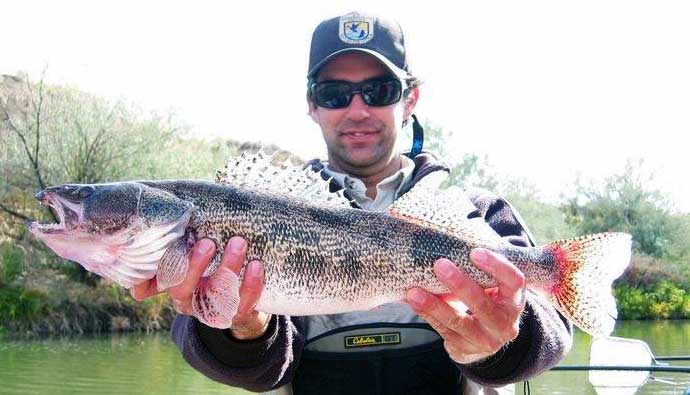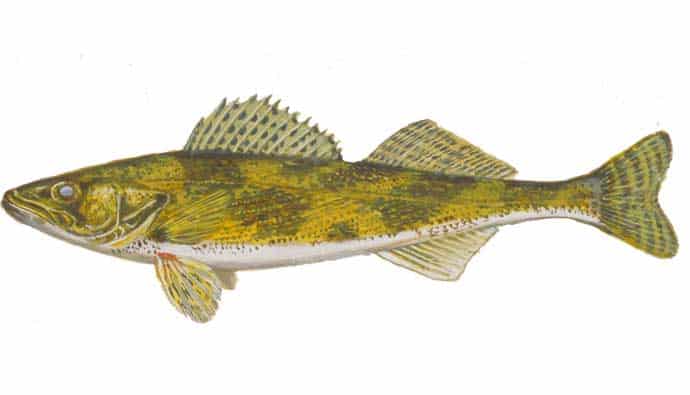Sauger is a popular fish that can be targeted all year round.
Depending on where you live, you can go after them ice fishing during winter months or especially during spring in the southern regions.

It is often confused with its close cousin, the walleye, because of the stark similarities between the two species.
I hope you’re amped to go catch them. Use this guide to help you catch more during your next outing.
Recommended Sauger Fishing Gear:
- Rod: Ugly Stik GX2
- Reel: Penn Battle III
- Sauger Fishing Lure: Spro Bucktail Jig with tuffy minnow attached to the hook
Overview
We get asked a lot, what is a sauger?
Sauger is a freshwater species of fish that is a member of the largest vertebrate order called Perciformes. The fish can be found in North America, northern Europe, and Asia and it is known for its fighting spirit as well as delicious and flaky meat.
The sauger is a slender and spiny rayed fish that has two separate dorsal fins, a large mouth, and an upper jaw that extends to the hind edge of the eye. It has distinct botches on the sides as well as dark spots on the first dorsal fin.

Yet, unlike the larger and solid gold-colored walleye, the smaller sauger fish is brassy in color and have the same pattern all over their body. It often interbreeds with walleye if their ranges overlap to produce saugeye fish.
Sauger vs Walleye
The walleye vs. sauger question comes up a lot. Sauger’s resemble the walleye closely. What’s even crazier is that they cross-breed with walleyes to create saugeyes!
Body Color
The sauger will have dark black spots (blotches) or solid gold markings on its sides. Walleyes don’t have as pronounced dark markings.
Fins
They both have a similar shape dorsal fin. However, saugers will have black spots. The tails of walleyes have a white marking on the bottom, which should be easy to spot.
Size
Saugers are smaller than walleyes. Their body is more slender and tends to be shorter. If you want to compare the saugeye vs walleye, saugeyes are close to the size of walleyes and have the markings of the sauger.
Sauger Facts
| Scientific Name | Sander canadensis |
| Common Name(s) | Sauger, sand pickerel, sand pike, blue pickerel, pike, gray pike, blue pike, river pike, pike-perch, spotfin pike, jack, jack fish, jack salmon |
| Family | Percidae |
| Identifying Characteristics | It is a slender and spiny rayed fish that has two separate dorsal fins, a large mouth, and an upper jaw that extends to the hind edge of the eye. It has distinct botches on the sides as well as dark spots on the first dorsal fin. |
| Depth Range | They like water around 62 and 72 degrees Fahrenheit. |
| Habitat | The fish can be found in North America, northern Europe, and Asia. |
| Limits | Check your local regulations |
Sauger Fish Habitat
Sauger fish prefer to remain in cloudy and moving water as well as quite backwaters over sand, mud, or bedrock substrates. These are found along the mouth of tributaries and in deeper tailwaters over rock and rubble substrates near dams.
As a cool water species, it favors water that is about 67°F. It can also be found deep underwater in the Ottawa River in Ontario. It’s not uncommon to have sauger found in shallow lakes and other slow-moving bodies of water.
How to Catch Sauger
The best way to catch sauger is with a vertical jig. Use a large and heavy one that is about an ounce heavy and made of soft plastic. Make it more enticing by tipping it with a minnow so that the fish can locate it by its scent. A heavy jig will be able to sink 30 to 40 ft deep where the sauger is and won’t be buffeted much by the current.
Don’t worry about the fish’s smallmouth. It tends to pounce and pummel passing jig as it hops off the bottom so the fish will bite eventually. If you are fishing in water that is snag-free, you have a heavy lead head or a thin but heavy plastic-tipped jig that can pull well through the current.
Another way to catch them would be to do a split shot rig with a shiner on the hook. Drop it down to the bottom and wait for the bite.
Sauger Fishing Tactics
- You can fish them similarly to walleye, but they tend to hang out near the bottom. You’ll know when they hit because they tend to be more aggressive.
- Work the bait down till you touch the rocky bottom, and then begin a slow retrieve to maintain enough action to lure sauger.
- Use fat nightcrawlers as bait to catch sauger. The plump females will be more effective than the smaller bumpy-headed males.
Sauger Fishing Tips
- Hold for a minute once you have made contact with the bottom, and then lift the jig about 4 to 6 inches off it. Hold for 20 to 30 seconds before slowly retrieving it. This will make the bait look more realistic.
- When the sauger is less aggressive, use a lighter jig that you can trail behind upriver as your boat drifts in the current.
Sauger Seasons
Sauger can be found year-round except in mid-April and the end of May. The fish moves into the shallows during the day, but the best time to fish for it is at night, 30 minutes before sunrise and 30 minutes before sunset.
Wintertime is considered the best season to fish for sauger fish. The fish congregates in deep pools in river bends and in tailwaters below dams.
Sauger fishing Ohio River is very popular in the winter months!
How to Clean Sauger
- Place the fish on a clean cutting board with its belly towards you and the head on the left. If you are left-handed, rotate the fish 180° to the right.
- Make a cut-down and into the sauger fish right behind the pectoral fin and stop the knife when you reach the backbone.
- Turn the knife, and while pressing down on the back of the blade, cut along the spine and through the rib cage all the way to the tail and out. The whole fillet should come off at this point.
- Turn the fish over and repeat for the second fillet.
- Remove the still attached rib bones from the fillets by placing each skin side down. Cut behind the ribs and out to the belly, following the curve of the cage with the knife.
How to Cook Sauger
- Cut the fillets into manageable pieces.
- Beat 2 eggs in a bowl and set aside.
- Combine ½ a teaspoon of garlic powder, ½ a cup of all-purpose flour, and a pinch of salt in another bowl.
- Place 2 cups of crushed saltine crackers in a separate bowl.
- Heat oil in a frying pan over medium-high heat.
- Dip the fillets in the flour mixture, then in the eggs, and then in the cracker crumbs, and set on a separate plate. Dredge all the fillets this way.
- Lower two dredged fillets in the hot oil and cook till they turn golden brown on both sides (3 minutes per side).
- Place the cooked fish on paper towels and serve with lemon wedges.
Frequently Asked Questions
Sauger is a delicious fish. It has firm, white, and flaky meat that is sought after by seafood enthusiasts. Some say it is sweeter in taste than the walleye.
Saugers spawn in spring in water that is about 2 to 8 feet deep, and the young hatch in about 2 to 4 weeks.
Most sauger max out at about 15”.
Insider Advice
Sauger is incredibly pleasing to the palette which makes it an amazing table fish. Even if you catch small ones, you will enjoy a hearty meal after your fishing trip.




 Facebook
Facebook YouTube
YouTube








